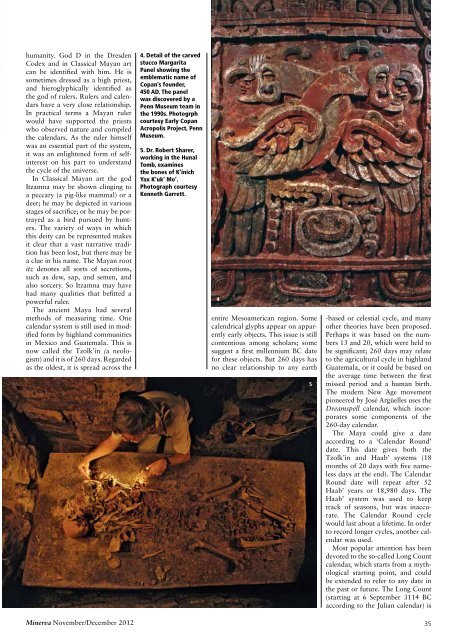Following Odysseus Not the end of the world Amarna city of light ...
Following Odysseus Not the end of the world Amarna city of light ...
Following Odysseus Not the end of the world Amarna city of light ...
- No tags were found...
You also want an ePaper? Increase the reach of your titles
YUMPU automatically turns print PDFs into web optimized ePapers that Google loves.
humanity. God D in <strong>the</strong> DresdenCodex and in Classical Mayan artcan be identified with him. He issometimes dressed as a high priest,and hieroglyphically identified as<strong>the</strong> god <strong>of</strong> rulers. Rulers and cal<strong>end</strong>arshave a very close relationship.In practical terms a Mayan rulerwould have supported <strong>the</strong> priestswho observed nature and compiled<strong>the</strong> cal<strong>end</strong>ars. As <strong>the</strong> ruler himselfwas an essential part <strong>of</strong> <strong>the</strong> system,it was an en<strong>light</strong>ened form <strong>of</strong> selfintereston his part to understand<strong>the</strong> cycle <strong>of</strong> <strong>the</strong> universe.In Classical Mayan art <strong>the</strong> godItzamna may be shown clinging toa peccary (a pig-like mammal) or adeer; he may be depicted in variousstages <strong>of</strong> sacrifice; or he may be portrayedas a bird pursued by hunters.The variety <strong>of</strong> ways in whichthis deity can be represented makesit clear that a vast narrative traditionhas been lost, but <strong>the</strong>re may bea clue in his name. The Mayan rootitz denotes all sorts <strong>of</strong> secretions,such as dew, sap, and semen, andalso sorcery. So Itzamna may havehad many qualities that befitted apowerful ruler.The ancient Maya had severalmethods <strong>of</strong> measuring time. Onecal<strong>end</strong>ar system is still used in modifiedform by highland communitiesin Mexico and Guatemala. This isnow called <strong>the</strong> Tzolk’in (a neologism)and it is <strong>of</strong> 260 days. Regardedas <strong>the</strong> oldest, it is spread across <strong>the</strong>4. Detail <strong>of</strong> <strong>the</strong> carvedstucco MargaritaPanel showing <strong>the</strong>emblematic name <strong>of</strong>Copan’s founder,450 AD. The panelwas discovered by aPenn Museum team in<strong>the</strong> 1990s. Photogrphcourtesy Early CopanAcropolis Project, PennMuseum.5. Dr. Robert Sharer,working in <strong>the</strong> HunalTomb, examines<strong>the</strong> bones <strong>of</strong> K’inichYax K’uk’ Mo’.Photograph courtesyKenneth Garrett.4entire Mesoamerican region. Somecal<strong>end</strong>rical glyphs appear on apparentlyearly objects. This issue is stillcontentious among scholars; somesuggest a first millennium BC datefor <strong>the</strong>se objects. But 260 days hasno clear relationship to any earth5-based or celestial cycle, and manyo<strong>the</strong>r <strong>the</strong>ories have been proposed.Perhaps it was based on <strong>the</strong> numbers13 and 20, which were held tobe significant; 260 days may relateto <strong>the</strong> agricultural cycle in highlandGuatemala, or it could be based on<strong>the</strong> average time between <strong>the</strong> firstmissed period and a human birth.The modern New Age movementpioneered by José Argüelles uses <strong>the</strong>Dreamspell cal<strong>end</strong>ar, which incorporatessome components <strong>of</strong> <strong>the</strong>260-day cal<strong>end</strong>ar.The Maya could give a dateaccording to a ‘Cal<strong>end</strong>ar Round’date. This date gives both <strong>the</strong>Tzolk’in and Haab’ systems (18months <strong>of</strong> 20 days with five namelessdays at <strong>the</strong> <strong>end</strong>). The Cal<strong>end</strong>arRound date will repeat after 52Haab’ years or 18,980 days. TheHaab’ system was used to keeptrack <strong>of</strong> seasons, but was inaccurate.The Cal<strong>end</strong>ar Round cyclewould last about a lifetime. In orderto record longer cycles, ano<strong>the</strong>r cal<strong>end</strong>arwas used.Most popular attention has be<strong>end</strong>evoted to <strong>the</strong> so-called Long Countcal<strong>end</strong>ar, which starts from a mythologicalstarting point, and couldbe ext<strong>end</strong>ed to refer to any date in<strong>the</strong> past or future. The Long Count(starting at 6 September 3114 BCaccording to <strong>the</strong> Julian cal<strong>end</strong>ar) isMinerva November/December 2012 35
















